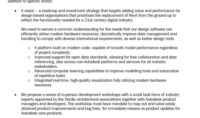The number of architecture firms requesting more development of Autodesk's flagship design platform, Revit, has increased to 116 by August 20. Companies such as Cooper Carry and Portman Architects have now signed an open letter originally released July 21 by IT consultant Iain Godwin, initially representing 17 UK-based firms.
San Rafael, Calif.-based Autodesk responded to the letter on July 31 in a blog post by Amy Bunszel, senior vice president for design and creation products, outlining the state of Revit development. She framed the lack of recent development for Revit software in terms of the company using its finite resources to invest more in engineering and construction products rather than in those for architecture and design.
"We have underinvested in architectural modeling functionality in recent years and are working to make that right," Bunszel said in the post. "We want to share some of the thinking behind our decision-making with Revit over the past years."
Bunszel wrote that Autodesk's goal with Revit has always been to maximize the value it brings to the the design and construction markets, and "to do that we must enable all major stakeholders to participate in the BIM process," she said. "In pursuit of this goal, we increased our product development to better serve engineering and construction customers. This required several platform projects to improve scalability and performance to support fabrication detail for engineering that also benefited all disciplines. The result of this was a slowdown in development on core architectural modeling capabilities."
Bunszel said Autodesk realizes and understands the impact the situation has had on its architecture and design customers, adding that the software firm has increased investment and resources in the architectural capabilities of Revit during the last quarter of 2019. She said it will take some time for the impact of the company's Revit investment last year to be fully realized, but said users could follow its Revit Public Roadmap to see when and where that investment will be realized.
Bunszel's blog did acknowledge that Revit customers hold a grievance about having gone through four different licensing models in the last five years, all with relatively little product development, but she did not offer any changes to the existing licensing plans.
"We’ve done our best to balance licensing changes with a more valuable experience and trade-in offers that give longtime customers a path to experience these benefits at a cost consistent with what they pay today," she said.
A cloud-based Revit, or even development of a separate design tool outside of the core platform, are ideas that Autodesk has mentioned as an eventual replacement for Revit as far back as 2016, but the company has not shared any further details on those developments. Autodesk CEO Andrew Anagnost wrote in a separate blog that "we have now turned our attention to defining and building out a new platform for (architecture, engineering and construction) based on an evolution of BIM centered on a common data environment. We are committed to the idea of new, highly collaborative and outcome-driven design solutions for the AEC industr(ies)."
Anagnost said that some of Autodesk's largest customers have seen the company's plans for a new platform, most have not and that it would be sharing more details of that platform this year, initially under non-disclosure agreements.
Anagnost pushed back on the assertion that Autodesk's switch to subscriptions and now to named users has cost architecture firms more for the software.
"While it is true that our multi-user prices have increased in anticipation of the end of perpetual licensing, no customer has paid Autodesk dramatically more for the same level of usage in the last three to five years than they did in the past," he wrote.
"Powered by the cloud, with experiences spanning desktop, mobile and extended reality, this future [of architectural design] looks quite different than a desktop application with hundreds of buttons in the ribbon," Bunszel said. "Over the next major and point releases you’ll start to see proof points of this direction that you can react to and provide feedback on."
This article was updated August 27 to update the number of firms that have signed the letter and to include Autodesk CEO Andrew Anagnost's responses.






Post a comment to this article
Report Abusive Comment